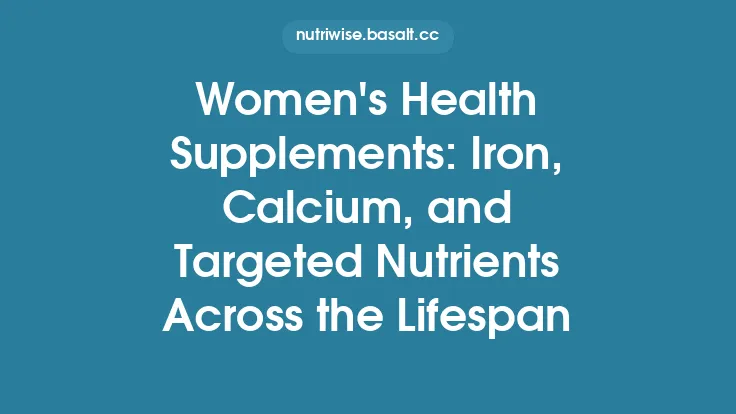The human body undergoes profound physiological transformations from the moment of conception through the later years of life. These changes affect how nutrients are processed, stored, and utilized, which in turn dictates the amount of supplemental vitamins, minerals, and other bioactive compounds that can be safely and effectively incorporated into a daily regimen. While the foundational principle of “more is better” is a common misconception, age‑specific dosage guidelines provide a framework for aligning supplement intake with the unique metabolic demands, organ capacities, and health priorities that characterize each stage of the lifespan.
1. Foundations of Age‑Based Supplementation
1.1 Why Age Matters
- Metabolic Rate: Basal metabolic rate (BMR) peaks in early adulthood and gradually declines with age, influencing the turnover of nutrients.
- Organ Maturity and Decline: The liver and kidneys, primary sites for nutrient metabolism and excretion, mature during childhood, reach peak function in early adulthood, and experience reduced efficiency in later decades.
- Hormonal Shifts: Puberty, pregnancy, menopause, and andropause introduce hormonal fluctuations that alter nutrient requirements (e.g., iron during menarche, calcium during menopause).
- Body Composition: Shifts in lean mass versus adipose tissue affect the distribution and storage of fat‑soluble vitamins and minerals.
1.2 Core Principles for All Ages
| Principle | Practical Implication |
|---|---|
| Start with Food First | Supplements should fill gaps, not replace a balanced diet. |
| Reference Established DRIs | Use Recommended Dietary Allowances (RDAs) or Adequate Intakes (AIs) as baselines. |
| Consider Safety Margins | Upper Intake Levels (ULs) protect against toxicity, especially in vulnerable groups. |
| Individualize | Genetics, health status, medication use, and lifestyle modify needs. |
| Monitor and Adjust | Periodic lab testing (e.g., serum 25‑OH vitamin D, ferritin) guides dose refinement. |
2. Infancy (0–12 Months)
2.1 Critical Nutrients
- Vitamin D: Breastfed infants receive limited vitamin D from milk; the American Academy of Pediatrics recommends 400 IU/day to support bone mineralization.
- Iron: Full‑term infants have sufficient iron stores for the first 4–6 months; thereafter, 11 mg/day of elemental iron is advised, especially for those exclusively breastfed.
- Vitamin K: A single intramuscular dose of 1 mg at birth prevents hemorrhagic disease; additional supplementation is rarely needed unless specific risk factors exist.
2.2 Dosing Considerations
- Formulation: Liquid drops with calibrated droppers ensure accurate dosing; avoid chewable tablets that pose choking hazards.
- Absorption Capacity: The immature gut has limited capacity for certain minerals (e.g., calcium); excessive supplementation can lead to gastrointestinal upset.
- Safety Net: Because infants have a low renal clearance, any supplement exceeding the UL can quickly become toxic (e.g., vitamin A toxicity at >300 µg retinol equivalents/day).
3. Early Childhood (1–8 Years)
3.1 Growth‑Driven Requirements
- Calcium & Vitamin D: Essential for rapid skeletal development; 1,000 mg calcium and 600 IU vitamin D per day are typical recommendations.
- B‑Complex Vitamins: Support high energy turnover; B12 (0.9 µg) and folate (150 µg) are crucial for neurodevelopment.
- Omega‑3 Fatty Acids (EPA/DHA): 70–100 mg/day of DHA may aid cognitive function, especially in children with limited fish intake.
3.2 Practical Dosing Strategies
- Chewable or Gummy Forms: Preferred for compliance, but ensure they are sugar‑free and contain minimal additives.
- Avoid Over‑Fortification: Many pediatric multivitamins already meet 100 % of the RDA for most nutrients; adding separate supplements can exceed ULs (e.g., zinc >20 mg/day may impair copper absorption).
- Weight‑Based Adjustments: For children at the lower end of the age range, dose scaling by body weight (mg/kg) can prevent inadvertent overdosing.
4. Pre‑Adolescence & Adolescence (9–18 Years)
4.1 Pubertal Surge in Nutrient Demands
- Iron: Female adolescents experience menstrual blood loss; 15 mg/day of elemental iron is often recommended, while males typically need 11 mg/day.
- Calcium: Peak bone mass accrues during this window; 1,300 mg calcium and 600–800 IU vitamin D daily are advised.
- Vitamin B12 & Folate: Support rapid DNA synthesis; 2.4 µg B12 and 400 µg folate per day are standard.
4.2 Special Populations
- Athletes: May require higher vitamin C (up to 200 mg/day) for collagen turnover and antioxidant protection, but should stay below the UL of 2,000 mg.
- Vegetarians/Vegans: Vitamin B12 supplementation (25–100 µg/day) is essential due to limited dietary sources.
- Eating Disorders: Monitoring for deficiencies (e.g., magnesium, zinc) is critical; supplementation should be guided by clinical assessment.
4.3 Dosing Tips
- Split Doses for Large Minerals: While not a focus on timing, large mineral doses (e.g., calcium >500 mg) are often better tolerated when taken in two separate servings throughout the day.
- Form Preference: Tablets with a smooth coating are easier for adolescents to swallow; flavored powders can be mixed into smoothies for those with taste sensitivities.
5. Early to Mid‑Adulthood (19–50 Years)
5.1 Maintenance of Peak Physiology
- Vitamin D: 600–800 IU/day maintains serum 25‑OH D levels >30 ng/mL in most adults; higher doses (1,000–2,000 IU) may be needed for those with limited sun exposure.
- Magnesium: 310–420 mg/day supports muscle function and cardiovascular health; many adults fall short due to dietary patterns.
- Omega‑3s: 250–500 mg EPA/DHA daily is linked to reduced triglycerides and improved cognitive health.
5.2 Gender‑Specific Adjustments
- Women of Reproductive Age: 400–800 µg folic acid daily to prevent neural tube defects in case of pregnancy; iron 18 mg/day if menstruating heavily.
- Men: Slightly higher zinc (11 mg/day) to support testosterone synthesis; however, stay below the UL of 40 mg to avoid copper deficiency.
5.3 Lifestyle Influences
- Shift Workers: May have altered vitamin D synthesis; consider modestly higher supplementation (up to 2,000 IU) after evaluating serum levels.
- High‑Stress Occupations: Vitamin C (200–500 mg/day) can offset oxidative stress, but chronic high doses (>2,000 mg) risk gastrointestinal disturbances.
6. Late Adulthood (51–70 Years)
6.1 Age‑Related Declines
- Calcium & Vitamin D: Bone resorption accelerates; 1,200 mg calcium and 800–1,000 IU vitamin D daily are commonly recommended.
- Vitamin B12: Gastric acid production wanes, impairing B12 absorption; 500–1,000 µg of cyanocobalamin or methylcobalamin sublingually can bypass the need for intrinsic factor.
- Coenzyme Q10 (CoQ10): Levels decline with age; 100–200 mg/day may support mitochondrial function, especially in individuals on statins.
6.2 Renal and Hepatic Considerations
- Reduced Clearance: The kidneys filter fewer metabolites; fat‑soluble vitamins (A, D, E, K) should be kept at or below the UL to avoid accumulation.
- Liver Enzyme Activity: Decreased cytochrome P450 activity can affect the metabolism of certain herbal extracts (e.g., St. John’s Wort), necessitating lower doses.
6.3 Practical Guidance
- Chewable Calcium Citrate: Better absorbed in low‑acid environments common in older adults.
- Liquid B12: Offers a reliable route for those with malabsorption; dosing can be weekly (1,000 µg) rather than daily, reducing pill burden.
- Monitor Serum Levels: Periodic testing (e.g., 25‑OH D, ferritin, B12) informs whether dose adjustments are needed.
7. Senior Years (71 Years and Beyond)
7.1 Heightened Vulnerability
- Vitamin D: Up to 2,000 IU/day may be required to maintain optimal serum concentrations, especially in institutionalized individuals with limited sunlight.
- Calcium: 1,200–1,500 mg/day, split into two doses, helps mitigate fracture risk while minimizing renal stone formation.
- Vitamin K2 (MK‑7): 90–120 µg/day can support vascular health by directing calcium to bone rather than arteries.
7.2 Polypharmacy Interactions
- Mineral Competition: High calcium intake can interfere with the absorption of certain medications (e.g., bisphosphonates, certain antibiotics). While timing is a separate topic, the dosage must be calibrated to avoid excessive calcium that could exacerbate drug interactions.
- Herbal Supplements: Elderly patients often use ginkgo, ginseng, or turmeric; conservative dosing (e.g., ginkgo 120 mg/day) reduces bleeding risk, especially when anticoagulants are present.
7.3 Safety Nets
- Upper Intake Levels: Seniors are more prone to surpass ULs due to cumulative supplement use. Regular medication and supplement reconciliation is essential.
- Renal Function Checks: Creatinine clearance should guide dosing of minerals like potassium and magnesium; excess can precipitate cardiac arrhythmias.
8. Special Physiological States Across the Lifespan
8.1 Pregnancy & Lactation
- Folate: 600 µg/day (as folic acid) to prevent neural tube defects.
- Iron: 27 mg/day to support fetal blood volume expansion.
- Vitamin D: 600–800 IU/day; some clinicians recommend up to 2,000 IU after confirming serum levels.
- Omega‑3 DHA: 200–300 mg/day for neurodevelopment.
8.2 Chronic Illnesses
- Diabetes: Magnesium (300–400 mg/day) can improve insulin sensitivity; however, renal function must be assessed.
- Osteoporosis: Higher calcium (1,200–1,500 mg) and vitamin D (1,000–2,000 IU) combined with vitamin K2 may enhance bone mineral density.
- Cardiovascular Disease: CoQ10 (100–200 mg) may mitigate statin‑induced myopathy; dosage should be individualized based on tolerance.
9. Practical Framework for Determining Age‑Specific Doses
- Baseline Assessment
- Review dietary intake, health history, and current medication list.
- Identify life stage (e.g., adolescent, pregnant, senior) and any physiological modifiers (e.g., menopause).
- Reference Established Guidelines
- Use RDAs/AIs and ULs from authoritative bodies (e.g., Institute of Medicine, EFSA).
- Adjust for body weight when appropriate (especially in children).
- Select Appropriate Formulation
- Liquid drops for infants, chewables for children, tablets/capsules for adults, sublingual or transdermal for seniors with absorption concerns.
- Start Low, Go Slow
- Initiate at the lower end of the recommended range, especially when introducing a new supplement or when renal/hepatic function is compromised.
- Monitor Biomarkers
- Schedule periodic lab tests (e.g., serum 25‑OH D, ferritin, B12, calcium) to verify adequacy and detect excess.
- Adjust Based on Feedback
- Modify dose upward if biomarkers indicate deficiency, or downward if signs of toxicity emerge (e.g., hypercalcemia, elevated liver enzymes).
- Document and Review
- Keep a supplement log, noting dose, formulation, and any adverse effects; review annually with a healthcare professional.
10. Common Pitfalls and How to Avoid Them
| Pitfall | Why It Happens | Prevention |
|---|---|---|
| Assuming “One Size Fits All” | Overreliance on generic multivitamins | Tailor doses to age, gender, and health status |
| Exceeding Upper Intake Levels | Stacking multiple supplements containing the same nutrient | Track total daily intake across all products |
| Neglecting Renal/Hepatic Decline | Ignoring age‑related organ changes | Adjust doses downward for seniors, especially for fat‑soluble vitamins |
| Using Adult Doses for Children | Convenience or lack of pediatric formulations | Choose pediatric‑specific products and dose by weight |
| Skipping Lab Confirmation | Belief that supplements are harmless | Periodic testing validates need and safety |
11. Future Directions in Age‑Specific Supplementation
- Precision Nutrition: Integration of genomics and metabolomics to predict individual nutrient needs across the lifespan.
- Smart Delivery Systems: Age‑targeted microencapsulation that releases nutrients in response to physiological cues (e.g., pH changes in the elderly gut).
- Longitudinal Cohort Studies: Ongoing research tracking supplement dosing from infancy to old age will refine current guidelines and uncover life‑stage specific risk‑benefit ratios.
Bottom Line
Age‑specific dosage guidelines are not merely a set of numbers; they embody a nuanced understanding of how the body’s capacity to process, store, and utilize nutrients evolves from birth through the golden years. By anchoring supplement decisions in established dietary reference intakes, adjusting for physiological changes, and continuously monitoring biochemical markers, individuals can safely harness the benefits of supplementation throughout every chapter of life.





